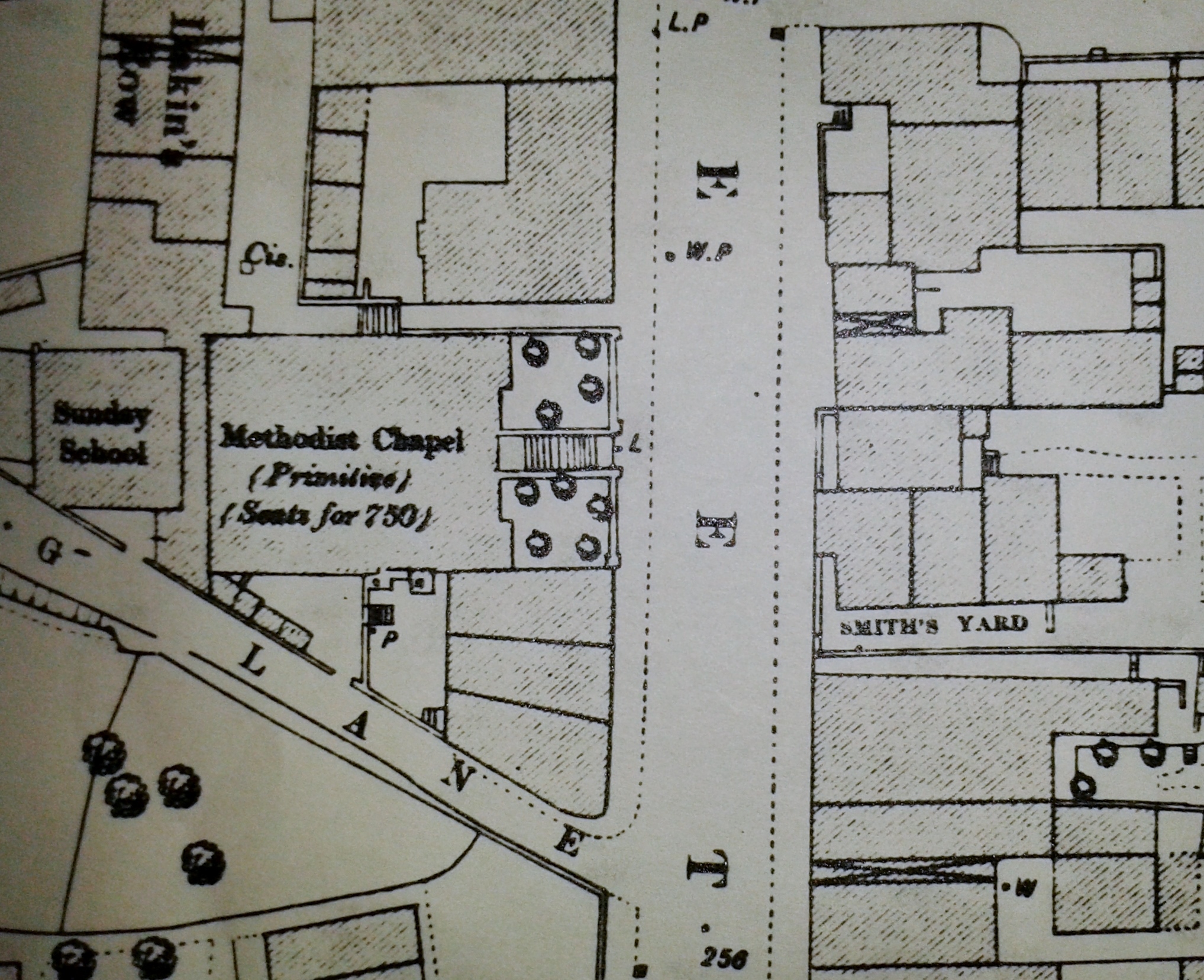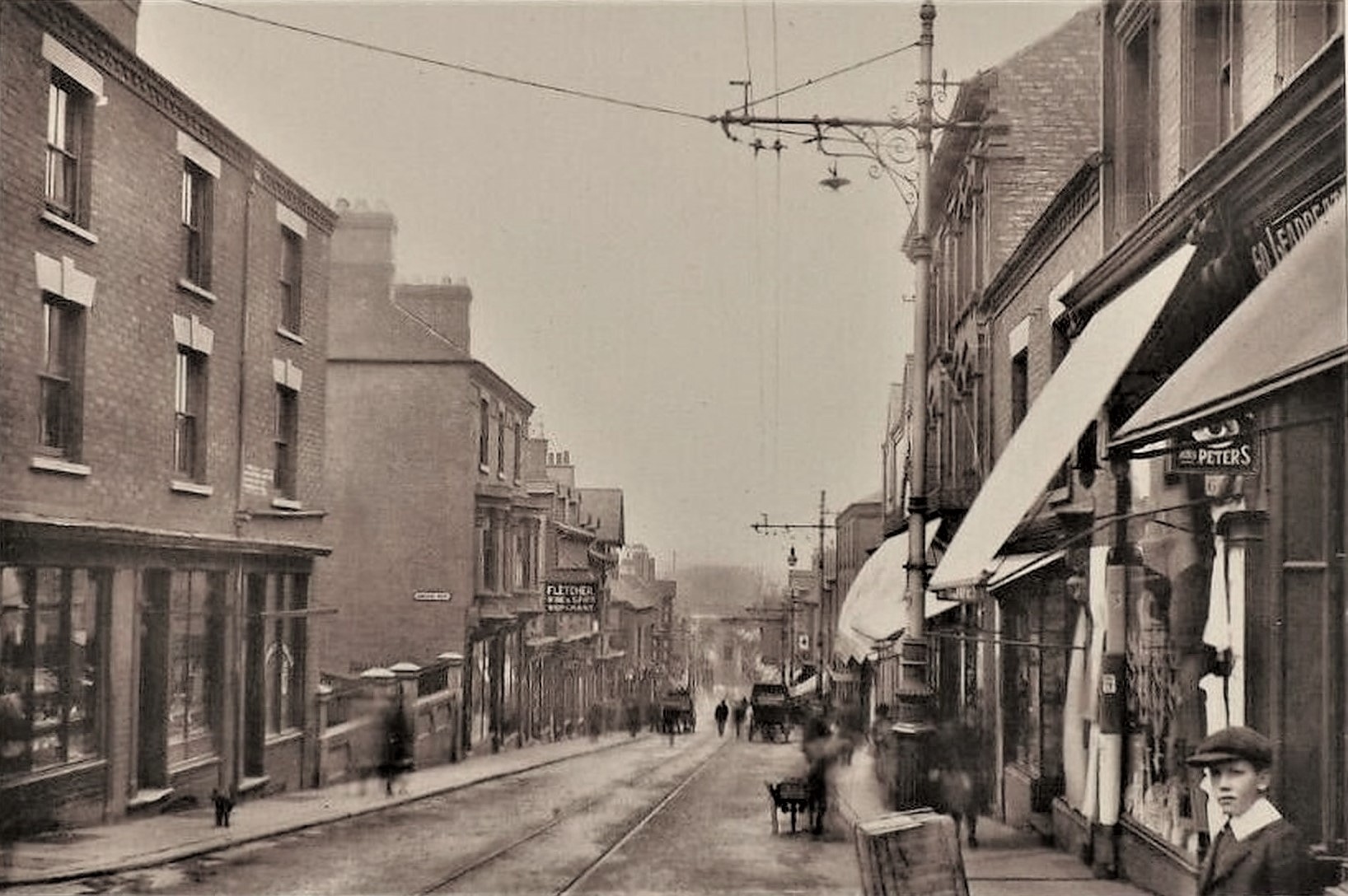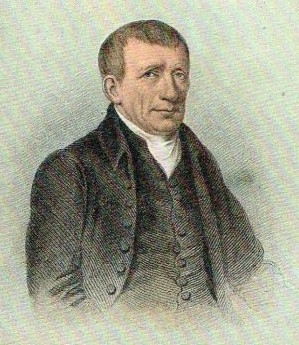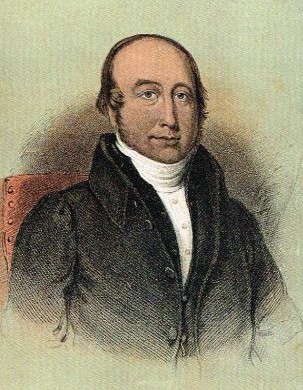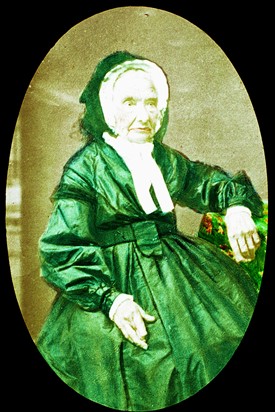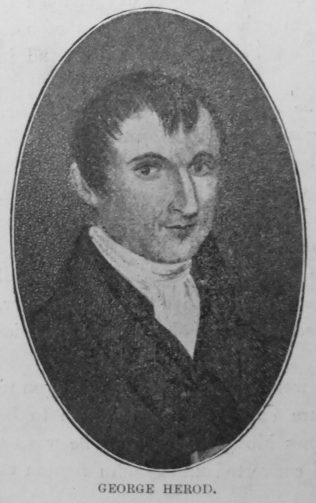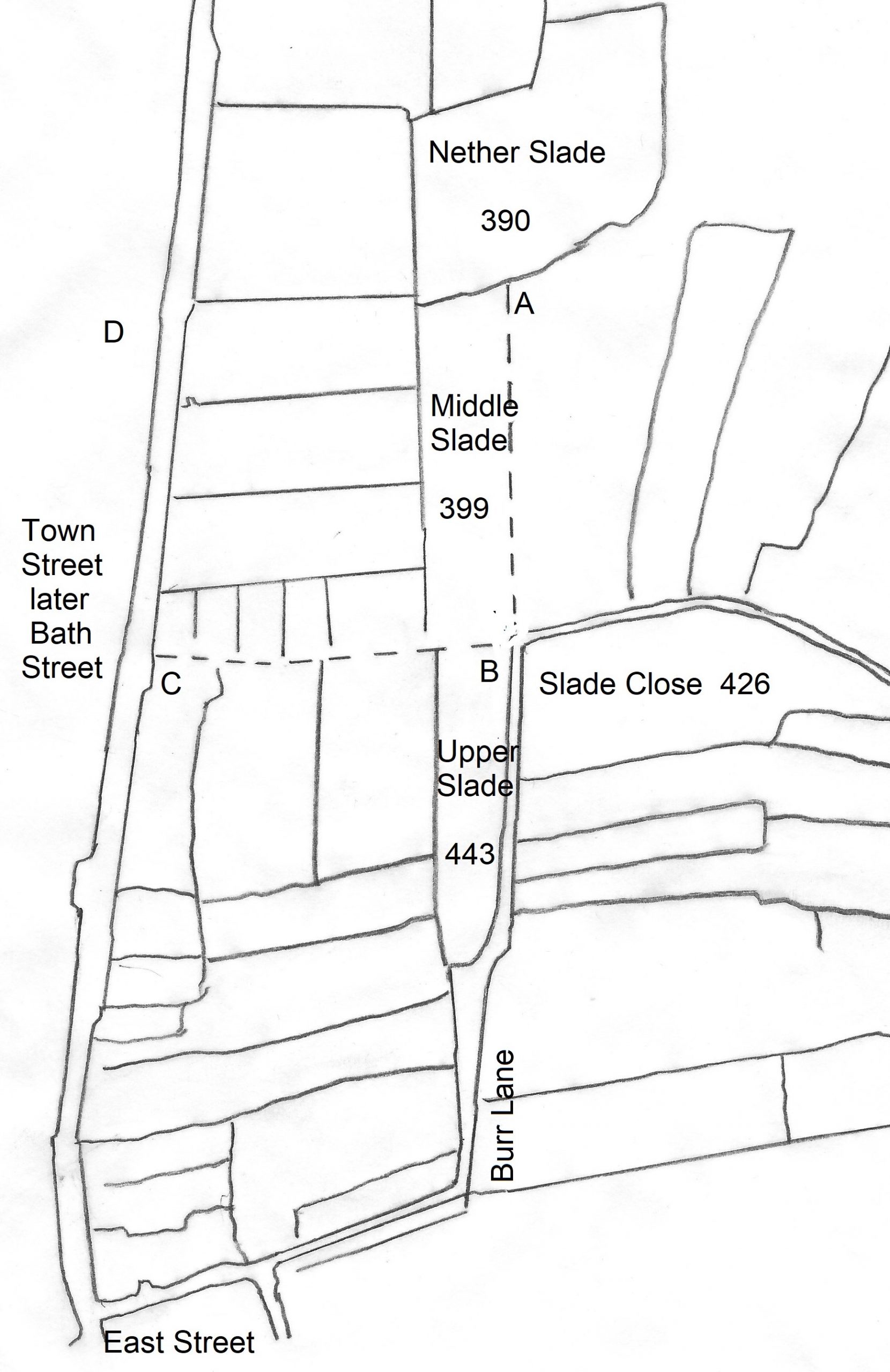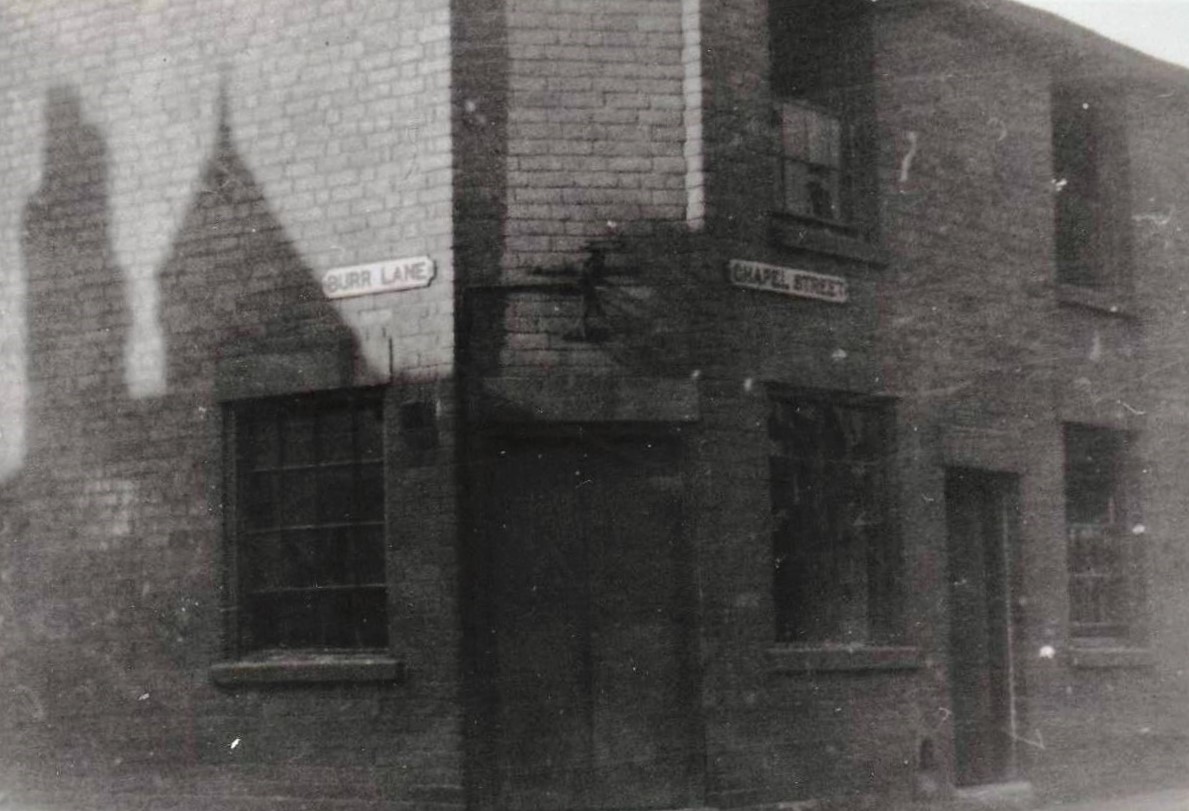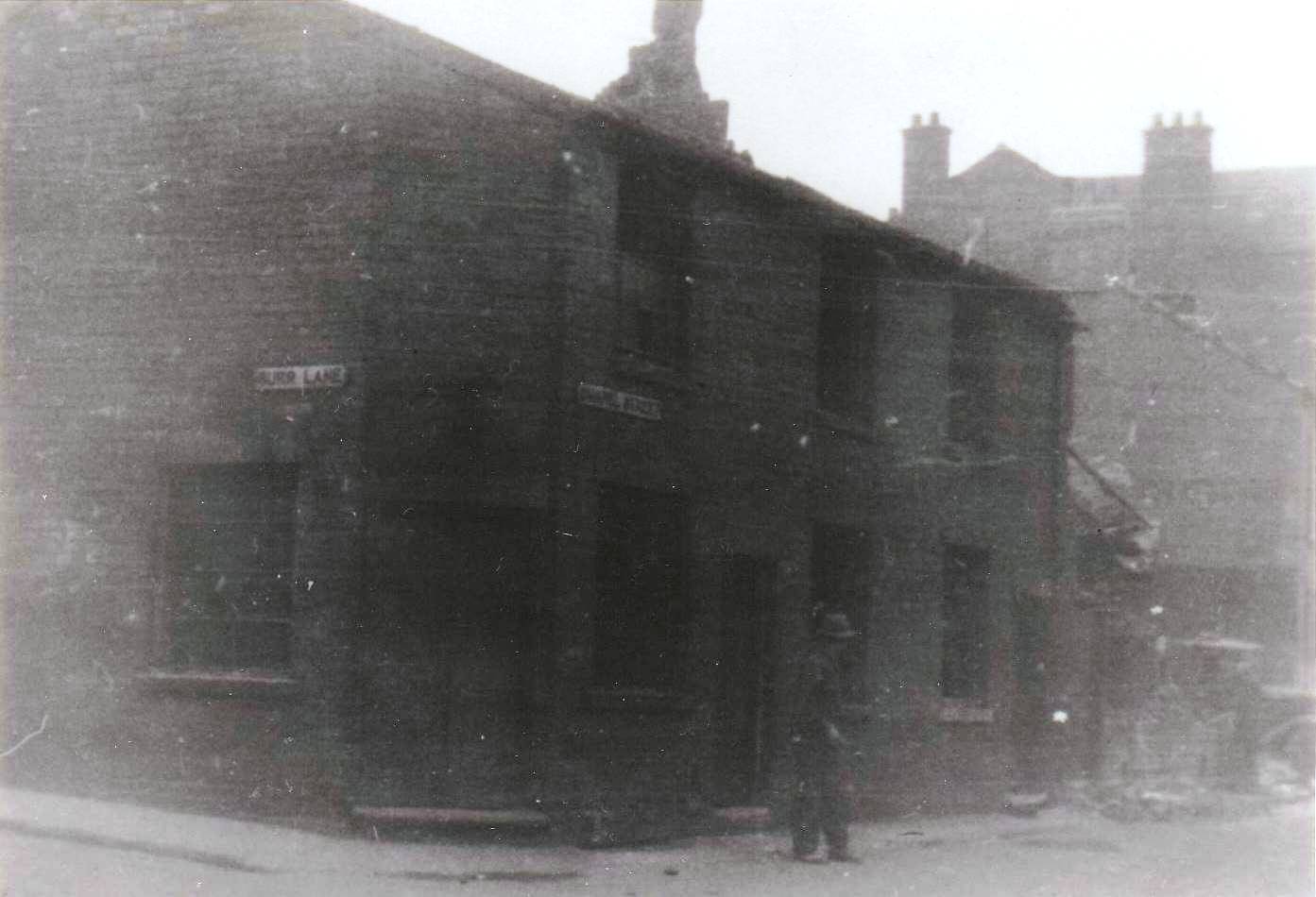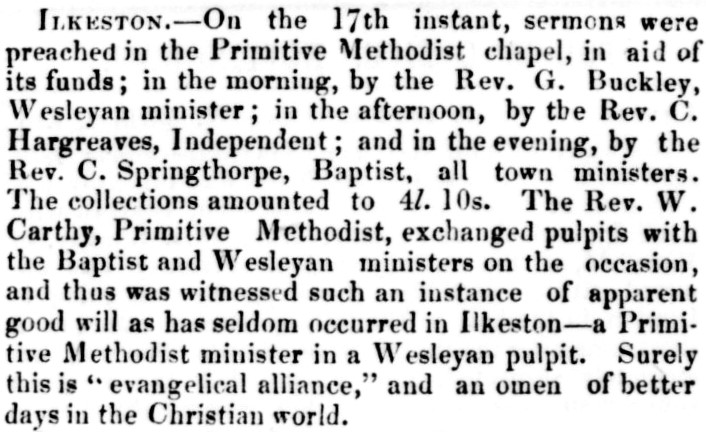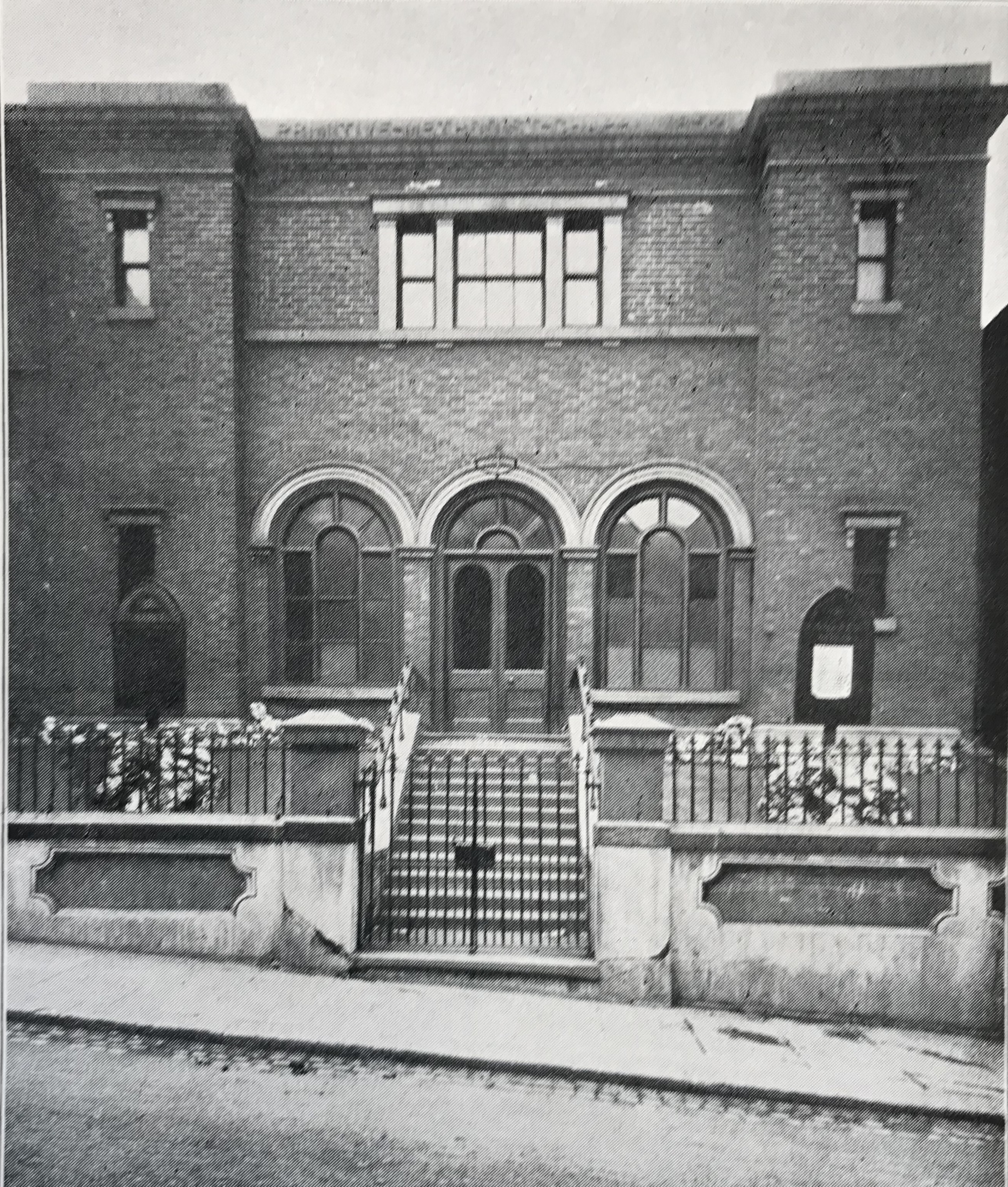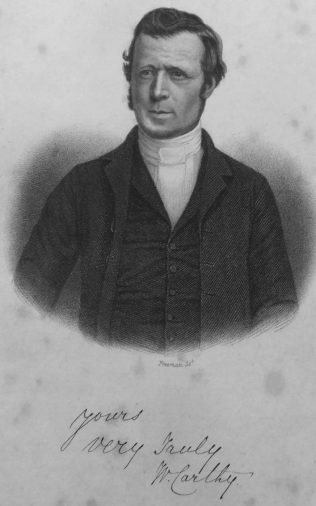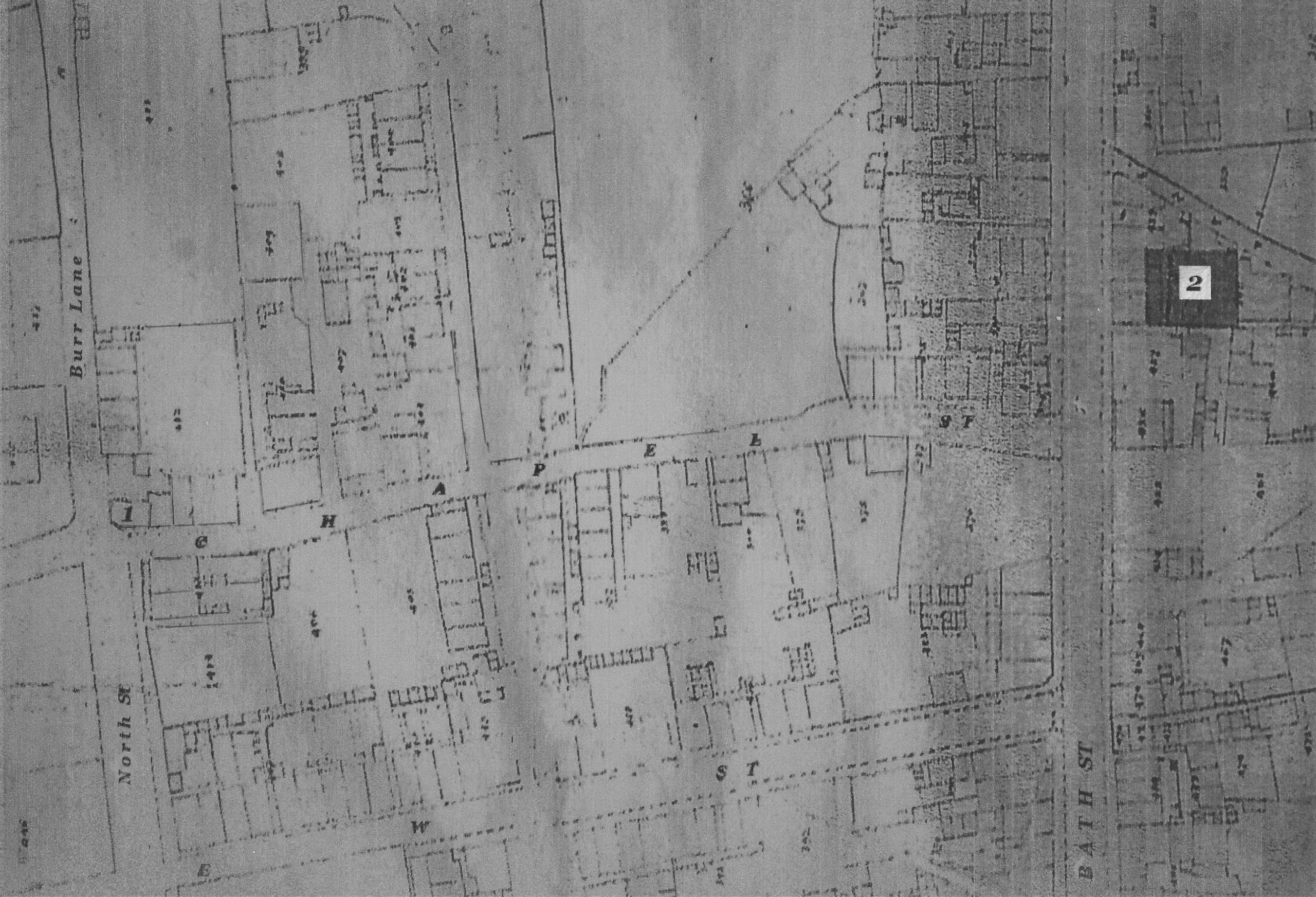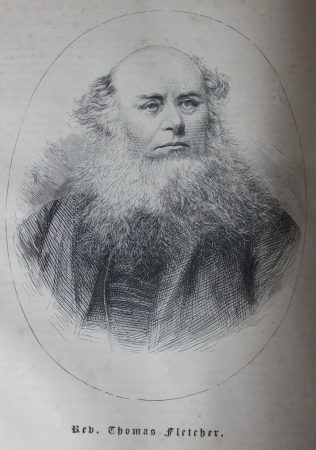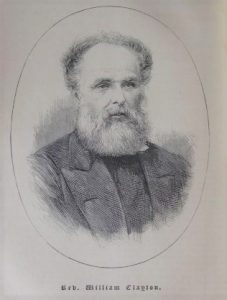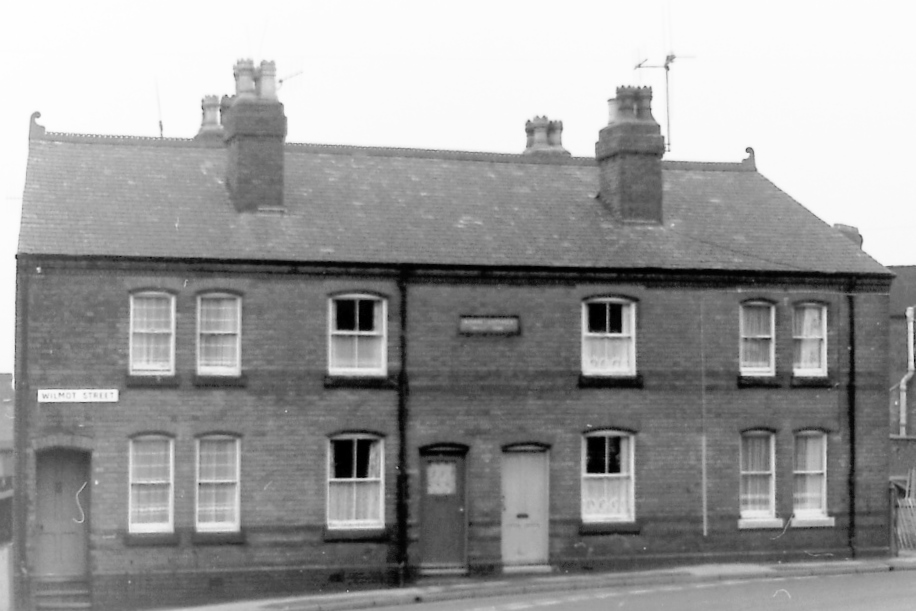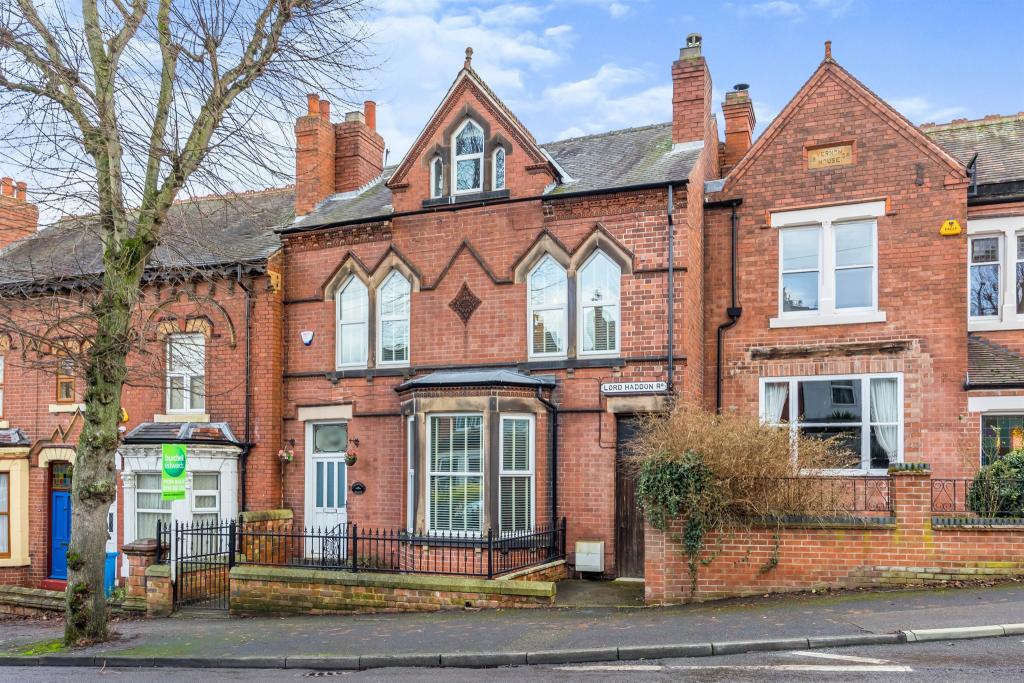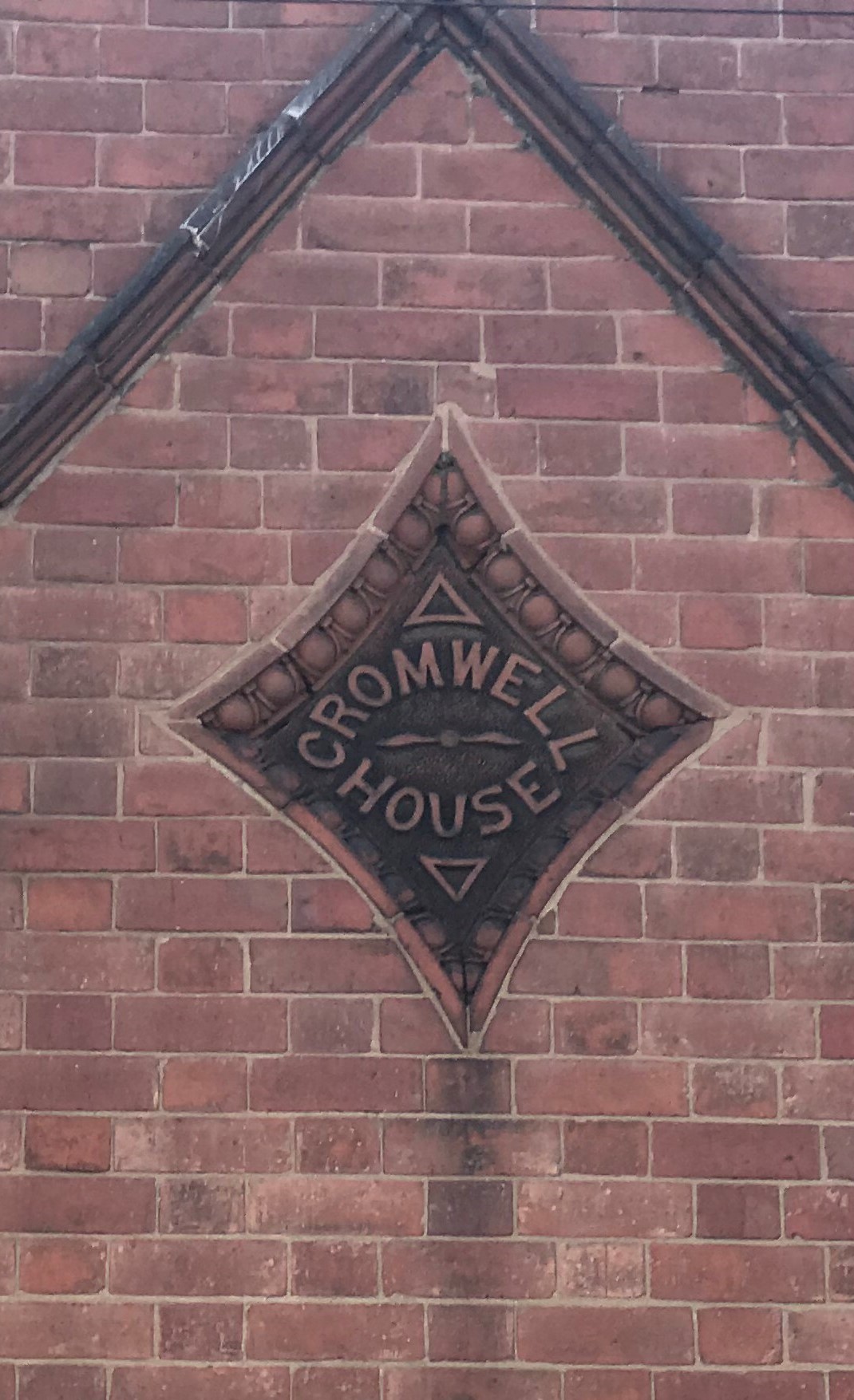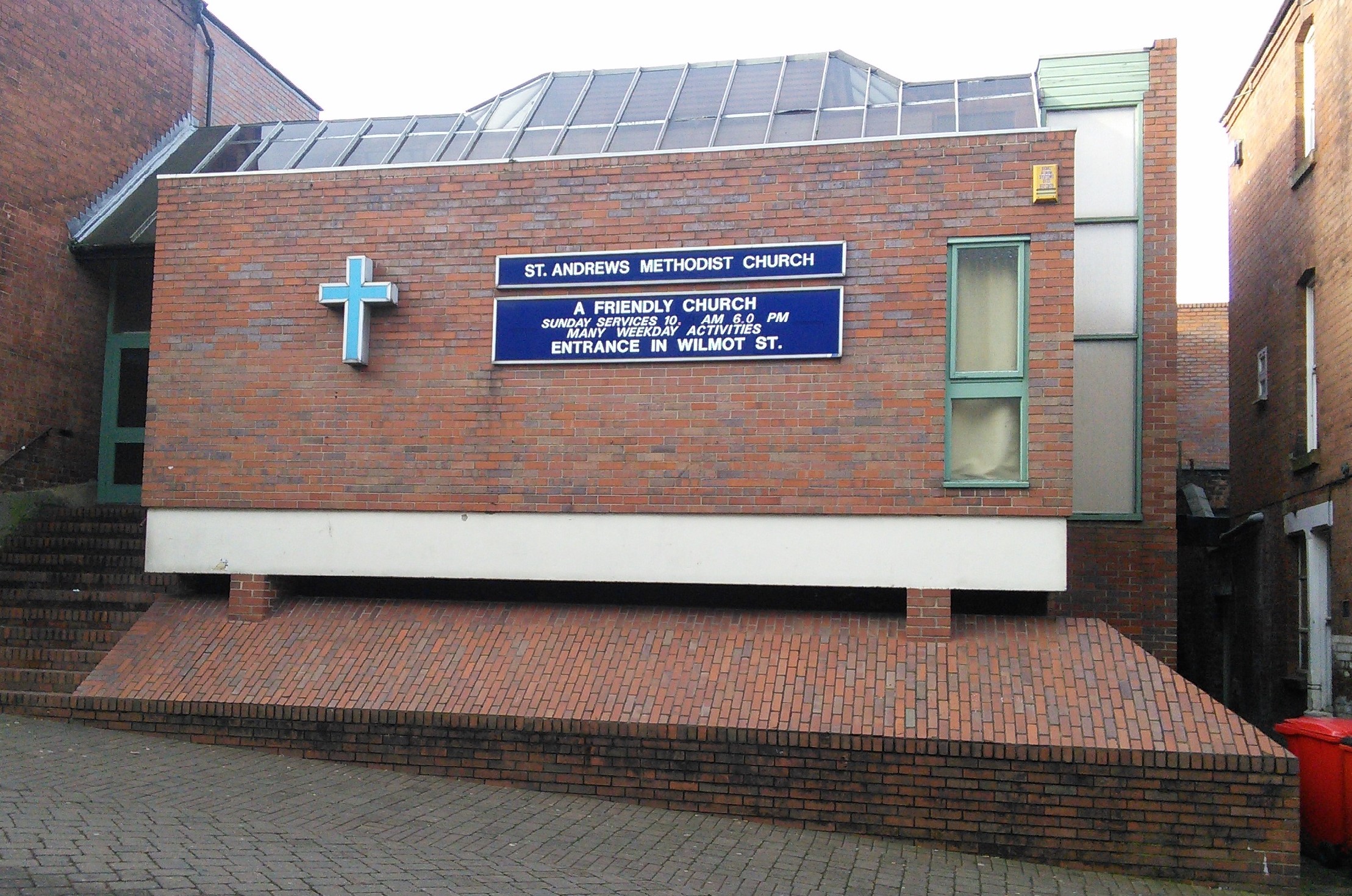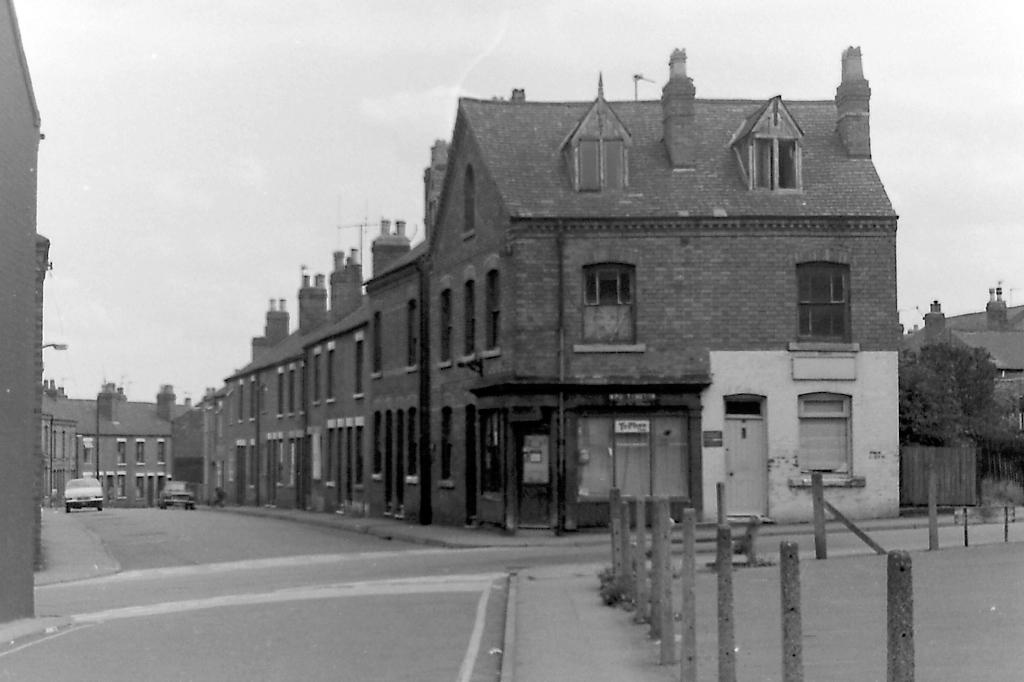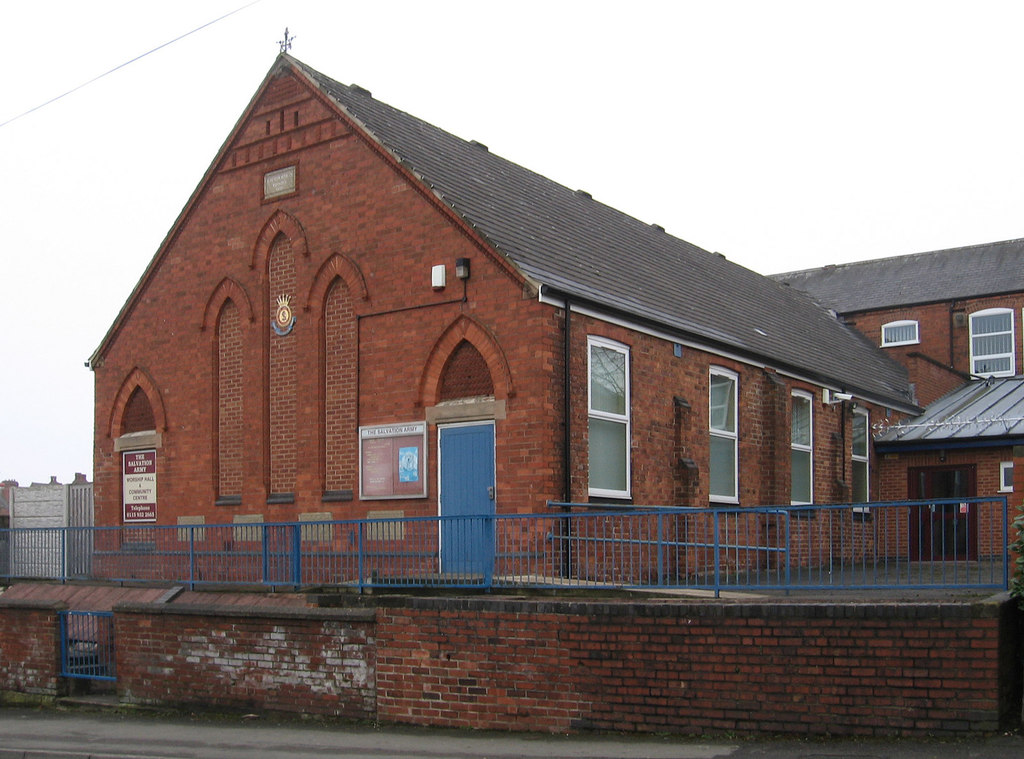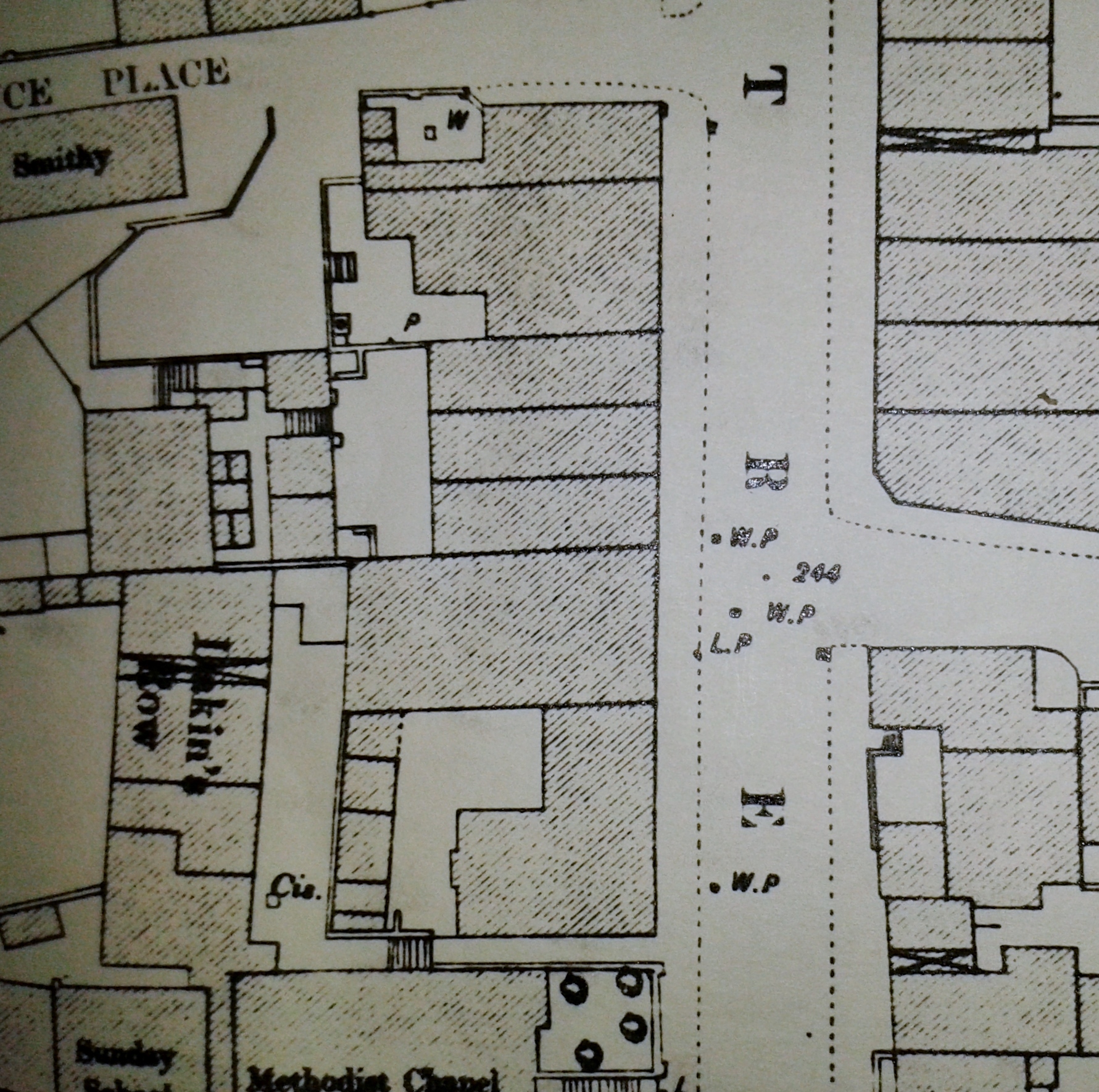Approaching the Chapel
This part of the west side of Bath Street takes in the section from Spring Lane to the bottom of Bath Street.
We start at Spring Lane (today known as Wilmot Street), walking past the Primitive Methodist Chapel to Providence Place. (From bottom to top of the map below)
Adeline introduces us to “the small shops against the Primitive Methodist Chapel.”
These were below Spring Lane and on the south side of the chapel. You can see a row of three premises on the map below (c1880)
“These shops were very seldom let, as most of the business at that time was done in the upper part of Bath Street.”
Plus ça change, plus c’est la même chose.
If you look on the 1871 Ilkeston census you will find, at this point, a couple of lock-up shops, before the grocery premises of Sarah Orchard (nee Whitfield), the widow of Henry Martin Orchard, master grocer. Boarding with her is Thomas Tanfield, Primitive Methodist Minister — not far to walk to work ?!!
“The old Primitive Methodist Chapel was in Chapel Street. I believe it has been converted into a dwelling house. When we lived in the old house in Bath Street (now a cinema is on the site), and my maternal grandmother paid us a visit, she went to that chapel. It was not far from our house, and as she was lame, that was a consideration. I always accompanied her on these occasions, and I have heard her say that she enjoyed the services.”
On the map above you can just see the Bath Street end of Chapel Street at the top, on the right.
And below, as we come out of Spring Lane (on the left hand edge of the photo) we can see the row of small shops, standing against the Primitive Methodist Chapel. The chapel stands back from the road and so is obscured. The sign for Daykin’s Row on the right is visible above the front wall of the chapel.
———————————————————————————————————————————————–
The Primitive Methodist Movement
The Movement developed in the early years of the nineteenth century, born out of a dispute within the Wesleyan Methodist church. Hugh Bourne and William Clowes were two Wesleyans who offended the Establishment members of their church movement with their fervent evangelicalism.
About 1800 Hugh, a native of Bucknall, Stoke-on-Trent, had travelled several miles north up to the area of Harriseahead and Mow Cop on the Staffordshire-Cheshire border and was quite shocked by what he found there.
“There was not in England a neighbourhood that was more ungodly and profane. A stranger could hardly go over Harriseahead without insult and sometimes not without injury” was his less than charitable judgement of the area.
He began a series of meetings in the area to fan the flames of religious revival. Initially these were prayer and Bible study meetings, but with his friend William Clowes, Hugh held ‘Camp-Meetings’……. American-style, all-day, open-air prayer and preacher meetings which were anathema to the Methodist authorities who regarding them as “highly improper and likely to be of considerable mischief”.
Having been issued with several warnings which they chose to ignore, firstly Hugh and then William were by 1810 expelled from the Methodist Church.
Not dispirited, they set up their own society.
A chapel was built at Tunstall, Staffordshire in 1811 and soon the Primitive Methodist Church was founded.
The name was taken from a statement made by John Wesley in 1790;
“I still remain a primitive Methodist”….primitive meaning ‘early’ or ‘original’ and not ‘undeveloped’ — these evangelists were reviving John Wesley’s original ways.
Adeline tells us that “the people who attended (the chapel) in those days were called Ranters, because of their fervour, but now they are treated with more respect.”
Adeline’s ‘Ranters’ were originally followers of Hugh Bourne but later the term was applied more generally to members of the Church who would wave their arms and stamp their feet in chapel, raise their voices in prayer, and parade through the streets, singing hymns.
———————————————————————————————————————————
An article in the Ilkeston Advertiser (1916) celebrating the centenary of the Primitive Methodist Church in Ilkeston, and other articles from the same newspaper 50 years later, mention the following events in the story of Primitive Methodism in Ilkeston, to which a little more detail has been added.
Timeline ….
1 … In 1811, aged 17, Sarah Kirkland of Mercaston, Derbyshire was so impressed by a group of ‘Ranters’ that she decided to devote her life to the Lord and within two years she was accepted into the movement as a preacher, its first female travelling preacher. Unlike the Wesleyan Methodists of this time, the ‘Prims’ encouraged women evangelists.
It is said that Sarah’s first convert was a gypsy boy at Sutton-on-the-Hill, a few miles west of Derby, who thereafter made it his task to travel with her, and announce Sarah’s arrival in every town and village that she might visit.
And one place that she did visit in August 1816 was Ilkeston.
What would the young ex-gypsy have made of the people as he led Sarah and her band of ‘Ranters‘ into the town?
And what would they have made of him?
Many of the population, hardened miners and their families, were not reluctant to share handfuls of filth and mouthfuls of foul language with strangers.
2 …. George Herod (1797-1862) was another pioneer of the church in the area and its first home missionary.
He reported on Ilkeston thus; “The condition of the people as to roughness and rudeness is like that of the natives of Mow Cop in 1800 before the first Revival” — not a compliment !!
“In prayer, he was powerful; his preaching abilities were acceptable; his style was clear, impressive, varied, and practical. The matter of his sermons was always important, naturally arranged, and delivered with energy. He was remarkable for promptitude, indefatigable industry, and indomitable firmness. There was intrepidity about all his movements, and a restlessness in trying to improve some part of the machinery, in order to move more effectually the great work with which he stood identified. His understanding was more quick than profound; his natural temper was sanguine and confident; he possessed good moral principles, truth in the inward parts, and unbending integrity. When he lacked patience with an opponent, he sometimes got foes in business meetings. But whatever infirmity he laboured under, he was a laborious, unwearied, and successful missionary and minister.” (from George’s Obituary in the Primitive Methodist Magazine 1862)
3 …. It seems however that these early evangelists achieved some success.
In 1817 a room in a house in Florence Square, off Wood Street, was acting as the first meeting place of the Primitive Methodists in Ilkeston although worshippers ‘were subjected to great annoyance from the lower order of the inhabitants’.
The room continued in use until the ‘Prims’ moved to their Old Slade Chapel in Chapel Street.
Mr Herod was pleasantly impressed by the advances made.
“Few places within the same time have made greater progress morally and intellectually than Ilkeston”.
4 …. After Ilkeston, Sarah Kirkland moved on to Cotmanhay with the same results.
In the early 1820’s regular services were held in the houses of Job Fretwell at Cotmanhay and Hannah Wheatley at Shipley. Probably because these premises were proving too small, services moved to a barn belonging to the Ancient Druids Inn, a forerunner of the Methodist Chapel, at the corner of Bridge Street and Cotmanhay Road.
5 .… It was at this time that the ‘Old Slade Chapel’ was built in Chapel Street.
Bagshaw’s Directory of 1846 dates the chapel opening to 1823 with galleries erected in 1831.
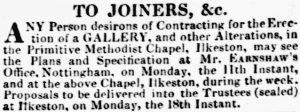 Nottingham Review and General Advertiser (July 8th 1831)
Nottingham Review and General Advertiser (July 8th 1831)
Other sources (e.g. Moorley) put the chapel building (incorrectly) ten years later, about 1833/4.
Its building was financed by public subscription and stood on the southern side of Chapel Street at its junction with Burr Lane.
The sketch map on the left is taken from William Gaultley’s map of 1795 with the numbers used by him. Not all the parcels of land are numbered or shown. No buildings are shown either.
The broken line from A to B marks the route of the later North Street. The line from B to C indicates the later Chapel Street. B is the approximate site of Slade Chapel.
The name ‘Slade‘ is taken from a group of Closes in this area.
There was Slade Close which was found on the opposite, north-east, corner of what was to be the junction of Burr Lane and Chapel Street. In the very bottom photograph, it is at the corner shop and the land behind it.
There was also Upper Slade which ran along the west side of Burr lane from about the former Albion Place to where Chapel Street joins Burr Lane; Middle Slade was on the west side of what was to be North Street, just north of its junction with Chapel Street to its most northern point; and there was Nether Slade, an area at the very bottom of what was to be North Street.
6 …. In 1830 Ilkeston was part of the Nottingham First Circuit which had 962 members and three ministers; the Circuit’s Ilkeston branch included the chapels at Ilkeston, Shipley Wood, New Stapleford, Beggarlee, Cotmanhay and Awsworth.
However in June 1834 Ilkeston became the head of a separate circuit with 333 members and two ministers. Two further separate circuits were later added — the Bottesford (1835) and Nottingham North Circuits (1845) — leaving the parent circuit, called Nottingham South Circuit, with 1023 members and four ministers.
By 1850 the ‘Prims’ had a recorded national membership of 104,762, with 519 travelling preachers, 8524 local preachers and 5170 chapels.
from the Nottingham Review (December 1842) — to what does this refer ?
7 …. In the late 1840’s and early 1850‘s the expanding congregation of the Slade Chapel was clearly demonstrating the building’s limitations, ‘added to which it was nearly inaccessible in winter time, owing to the wretched state of the roads’. (NR May 1852)
The photos, below, are courtesy of Andrew Knighton’s personal collection. He writes that “the photographs are of the main entrance to the Primitive Methodist Chapel that stood on the corner of Chapel Street / Burr Lane. They are unfortunately of poor quality, although the only images I know of, of the building”.
The chapel had no regular school-rooms so that the 300 scholars who attended the Sunday school had to be instructed in the chapel itself or upon adjacent ground. The ‘anxious wish‘ for replacement premises was manifest .. what held back this desire for becoming reality was the inability to procure the land for a building.
The Rev. William Carthy was in charge of the chapel in 1849 when an episode in which he was involved illustrates his character and concerns. Edward Miller-Mundy, M.P. for the South Derbyshire constituency had just died and his relative, William Mundy, was chosen, unopposed, to take his place. He was the owner of Mackworth village near Derby and had recently put restrictions upon the long-standing Wesleyan Society of that place, making it almost impossibke for the Society to continue its work. So, when William Mundy decided to tour his prospective constituency to make himself known, he was admonished by the Rev. Carthy at Ilkeston when he visited the town.
Peace and harmony among the town’s Dissenters: June 19th, 1849
8 … The 1851 Religious Census shows a national membership of 106,074.
The same 1851 Census records 1823 and 1824 as the building date for the Slade Chapel with accommodation for 330 people.
Its Sunday morning attendance was 60 and the Sunday School numbered 105, while the afternoon School figure was 190 and the evening congregation was 300.
This information was supplied by the chapel steward, John Robinson of Bath Street, mining agent to the Butterley Company.
9 …. In early 1850 negotiations were entered into with the Duke of Rutland with a view to the Methodists purchasing a plot of his land in Bath Street, land which was eventually bought in April 1852.
10 …. On New Year’s Day of 1852 a large tea-meeting was organised by the Rev. Carthy, at the British School, to raise funds for the building of the new chapel. After the tea, two simultaneous public meetings were held at the School and at the old Chapel at which an estimated 700-800 people attended.
11 …. The Primitive Methodist Chapel was … built in 1852.(writes Adeline)
As a result of the enterprise and work of the Rev. William Carthy, Circuit superintendent minister from 1848 to 1853, the new Primitive Methodist Chapel in Bath Street was built in 1852, at a cost of £1,300.
In the following year a new chapel for the Primitive Methodists was also built in Cotmanhay.
12 … White’s Directory of 1857 describes the new Ilkeston chapel on Bath Street as a ‘good brick building, capable of seating 600 hearers, to which are attached excellent school rooms for the Sunday scholars’.
13 …. William Carthy was born at Alrewas, Staffordshire in 1805, became a local preacher in 1827 and a minister two years later.
He served in the Ilkeston Circuit twice as the Superintendent Minister — the first time from 1848-1852 when he was instrumental in organising the building of chapels at Ilkeston, Cotmanhay, Langley Mill, Kimberley, Cinderhill, Old Basford, and Heanor (Taghill).
“In chapel building he had few equals”
William returned to the district in 1859, but a year later his health declined; he died at his Ilkeston residence on Saturday, October 12th, 1861, aged 56.
He was never a favourite with publisher of the Ilkeston Pioneer but at his death the newspaper described him as one of the most laborious and persevering ministers ever stationed at Ilkeston, with ready tact and ingenuity, undaunted by opposition (which he was never short of !), tireless and hardworking.
After a funeral service at Ilkeston his body was conveyed by train to the General Cemetery at Nottingham, accompanied by about 70 members of his congregation.
Andrew Knighton has some interesting detail here: “Talking with an elderly relative in the 1980s about his recollections of my family, he had several references to the chapel. One of these refers to an old photograph of a minister – I’m guessing possibly William Carthy – that used to hang in Isaac and Sarah Knighton’s kitchen, presumably at 28 New Street (1871 census) then 12 Chapel Street (1881 census) and finally 28 Byron Street, which is where my relative would have remembered it around the very early years of the 20th century.
Apparently there used to be a public right of way between the Slade chapel and the Flower Pot pub, leading up past Ball’s factory to Albion Place. However, the owner of Ball’s factory at the time built a wall to block access so the chapel’s minister got hold of a sledge hammer and caused controversy by demolishing it. I would guess this would most likely have taken place in the 1840s, although there’s no mention of it in the chapel minute book I have for that period”.
(You might see the outline of this path from Chapel Street to Albion Place on the mar below.)
14 … The old Primitive Methodist chapel was then converted into two cottages – which Moorley states “were demolished at the end of 1982, after being unoccupied for several years” . This demolition date is almost certainly incorrect, as Andrew Knighton has pointed out.
The map below is adapted from a very ‘fragile’ section of the Local Board Map of 1866.
The site of the old Slade Chapel is shown at 1. Walking westwards (left to right), along Chapel Street and into Bath Street, we arrive at the 1852 Primitive Methodist Chapel at 2.
15 … In 1857 the Rev. Thomas. Fletcher arrived at the Chapel, to leave in the summer of 1859 … to go to Belper.
.
.
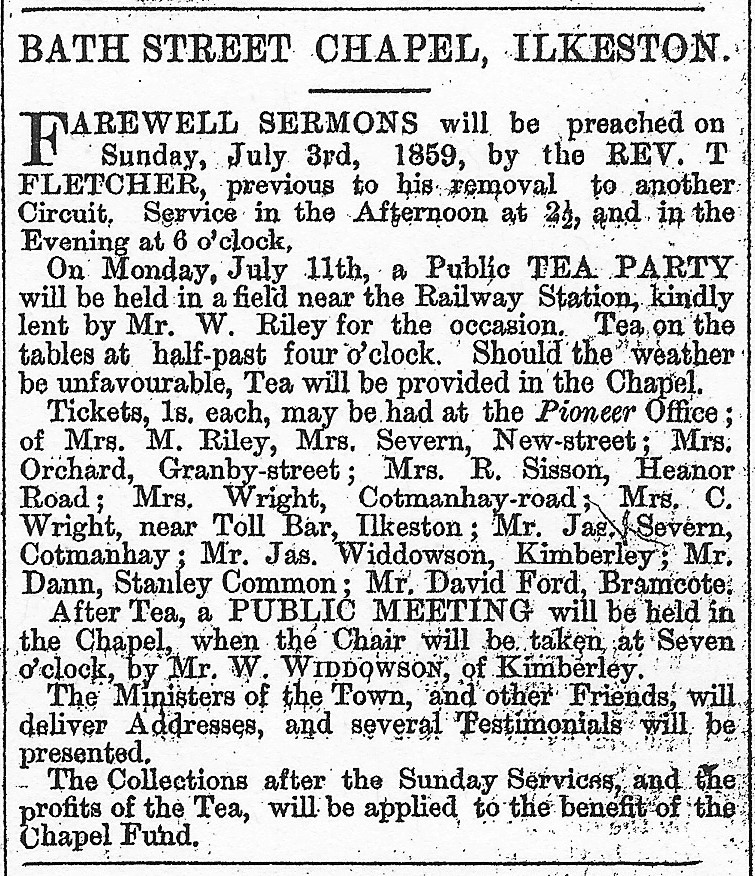
16 … In July 1866 William Clayton arrived from Grantham, Lincolnshire, as Superintendent of the Ilkeston Circuit.
At the end of the decade he and his family departed for Clay Cross.
He was back in Ilkeston from 1875 to 1878
William’s obituary records that his preaching was powerful, and his sermons truth on flame, heart-searching, apostolic and demonstrative of the Spirit.
17 … In 1875 the cause of the Primitive Methodists was taken to the community living down Nottingham Road where a couple of rooms in a cottage were converted into a makeshift chapel and a cupboard was used as a pulpit. Then, in January 1884, a new Methodist Chapel, built of brick with stone facings, was opened in Nottingham Road, at its corner with Little Hallam Lane. It was designed by architect Samuel Richards junior of Cotmanhay Road, son of grocer Samuel senior and Martha (nee Mellor). The builder was Frederick Shaw of the Manor House. This new chapel seated about 300 persons in more comfort. Later, on August 11th 1897, more foundation stones were laid to an extension for the original chapel. Once more the architect was Samuel Richards junior and Alfred Earnshaw of Burr Lane was its builder. Its cost was estimated at £300 and the occasion was attended by (amongst others) Samuel’s mother and mayoress Martha (nee Mellor) ….. the Mayor, Samuel senior, was ill at that time. In total, five foundation stones , all suitably inscribed, were laid at that time while a number of bricks were afterwards laid by children.
18 …. By 1888 Sunday School rooms and four cottages had been planned for Spring Lane — later Wilmot Street. There were to be ten rooms in all, the classrooms occupying the ground floor with the schoolroom over, all to accommodate 500 children. The architect was to be John Wills of Derby and the cost was projected to be £1050. He was also the architect of the four cottages (Bourne Cottages). Mr. Small (?) was the chosen builder.
Bourne Cottages in the recent past … courtesy of Jim Beardsley …. pre Sky dishes, UPVC, and re-tiling.
19 … By 1897 the Primitive Methodist Connexion had 197, 000 members, 4702 churches and 1125 other places of worship. The Church property was valued at £3,807,000 of which £1,000,000 was not yet paid for. Half-a-million people attended their sermons each Sunday, while there were 4000 Sunday schools with 61,700 Christian workers and half-a-million children.
20 … on July 29th, 1899 the memorial stone of the new manse for the chapel was laid in Lord Haddon Road, by George Woolliscroft, son of Charles (absent through illness). It was to be called Cromwell House.
Cromwell House (2023)
The plan to build the manse was approved in March 1899 and on July 29th the memorial stone was laid.
It was built of red bricks with stone dressings, in the semi-Gothic style with an entrance hall 7ft wide, four large rooms on the ground floor, and four on the first floor, a large attic and a cellar.
The architect was George Henry Nicklin and the builder was Edward L Clayton of Lord Haddon Road.
The estimated cost was £558.
Several townspeople had already subscribed to that cost including Alderman Francis Sudbury and Councillors Charles Mitchell and Joseph Scattergood.
21 … The Bath Street Chapel was demolished in 1973 and by 1975 had been replaced by a new one, on the same site, but now amalgamating with the Wesleyan Methodists whose chapel had stood a very short distance further south on Bath Street.
————————————————————————————————————————————————
A final glimpse of the site of the Old Slade Chapel at the confluence of Chapel Street and Burr Lane. The tarmacked area, bottom right, is where the chapel stood.
This shows the junction of Burr Lane/North Street, running right to left, and Chapel Street, running front to back in the 1960’s. The two cottages would have stood on the tarmac area, front right.
On Sunday morning, September 5th 1920, Mary Ann Keeling (nee Aldred), wife of grocer Stephen, died at her home at 13 Pelham Street, aged 88.
She had been a member of the Primitive Methodist Church since it had been built in Bath Street in 1852 and it was reported that she was the last Ilkestonian to have also been a member of the previous Slade Chapel in Chapel Street.
———————————————————————————————————————————
Ilkeston Mission Congregation
While one chapel left Chapel Street, some time later another place of worship made an entrance there in February 1890 when the memorial stones for a new chapel for the Ilkeston mission congregation were laid there — by Ilkeston residents, Councillor Samuel Wood, Thomas Barber, William Holbrook, and Samuel Leeke of London (the erstwhile Conservative candidate for Ilkeston). Each afterwards received a silver trowel for their work.
This mission had been in existence for nine years, led for most of that time by Alfred Jackson, and using an unhealthy wooden building on the same site as the planned new brick building — the latter designed by architect Thomas William Latham of Risley. It would accommodate about 750 folk, with a school at the rear for 50 scholars. Joseph Wade and William Holbrook were entrusted with the building, the total cost being an estimated £500-£600.
Photo by Dave Bevis (https://www.geograph.org.uk/photo/3382880)
The building was later to be occupied by the Salvation Army as its citadel. Let’s have a closer look at the Salvation Army in Ilkeston, 1880-1901, courtesy of Jennifer Floyd.
———————————————————————————————————————————
Daykin’s Row
“Lower down the street were two or three cottages, built back from the road, on top of the original bank”.
Here Adeline is possibly referring to Daykin’s (or Dakin’s) Row, deriving its name from occupant John Daykin, a lace agent.
Born in 1804 John was the son of framework knitter and Chelsea Pensioner Joseph and Ann (nee Briggs), and a cousin of Richard Daykin (who we met earlier in South Street).
John’s father Joseph was a Chelsea Pensioner …. On the 4th of October, 1856, there died at Ilkeston, an old veteran, named Joseph Daykin, who was formerly a sergeant in the Coldstream Guards, and was wounded by a musket shot in the head, at the landing at Camperdown, in Holland, in 1799, under General Abercrombie. At the time of his death he was 79 years old, and had enjoyed his pension 54 years . (Edwin Trueman .. History of Ilkeston 1880)
In the summer of 1854 there was a spate of ‘garden robberies’ at various places in town and one victim was the lace agent of Bath Street. In June he lost from his garden a score of his best cabbages, a whole bed of shallots and a crop of onions; John was determined to catch the culprits or at least give it a try.
Consequently on the Friday night following his loss, he positioned himself, carefully hidden and as comfortable as he could, in a cart in the garden. And then waited !!
The vigil did not last the whole night however — it started to rain so heavily that John decided to retire indoors and into his bedroom, overlooking the garden. Just about to get into bed, a noise from the garden alerted him to the possibility that the robbers had returned for more loot. Armed with hedge-cutters the intrepid lace-man descended to the garden and confronted three thieves, all well-known to John. One of them resisted the attempts to apprehend them and, in the scuffle which followed, lost part of a finger — chopped off by the cutters. The wounded fellow was taken indoors by John who bound the injury and then succumbed to the repentance tears, prayers and promises of the prisoners — he consented to free all of them and ‘give them another chance to amend their manner of living‘ … or to attack someone else’s garden !?!
John died in Daykin’s Row on June 23rd 1875, aged 70.
Adeline identifies .. “A waste piece of land in front of these cottages, and on the street level was where wheelbarrows, etc., were parked”.
Around here was the shop of chemist William Fletcher – at what was to be 34 and 35 Bath Street by 1881. When Bath Street was renumbered in the late 1880s, this side housed the odd numbers and William’s shop became number 69. He also had a branch in Granby Street.
A couple of years after marrying Emma Jane Taylor, on September 17th 1867, William and his family arrived in Ilkeston where he set up shop in Bath Street, and was to become a well-respected tradesman and community member of the town.
Many young men, apprenticed to William, would thank him for a valuable experience. One such apprentice was Samuel Daybell, eldest son of Ilkeston’s Superintendent of Police. In 1896 Samuel passed the exam of the Pharmaceutical Society of Great Britain ‘with the highest honours at the first attempt’…. thus becoming a fully qualified chemist and druggist. Young Samuel had worked with William for several years and it was this background which contributed significantly to his exam success .. as wel as his work with William’s son, William George, also a chemist and druggist.
Another apprentice was Robert James Platt who, after an apprenticeship, had later success with his own Ilkeston business.
And next door to chemist William – at 39 Bath Street in 1871 — was the New Inn.
and then Adeline point out “a road leading to the fields”. This would be in the area of what was later Providence Place, which you can see on the map above (c 1880), at the top left.
———————————————————————————————————————————
Before we continue our journey down Bath Street, let’s take a quick detour across the road and into Chapel Street to look at the Salvation Army in Victorian Ilkeston.

